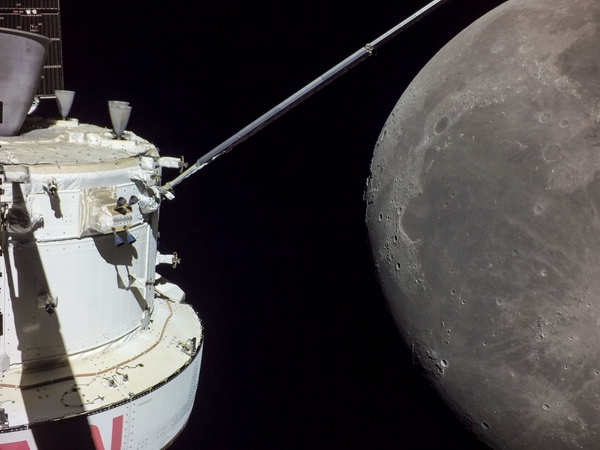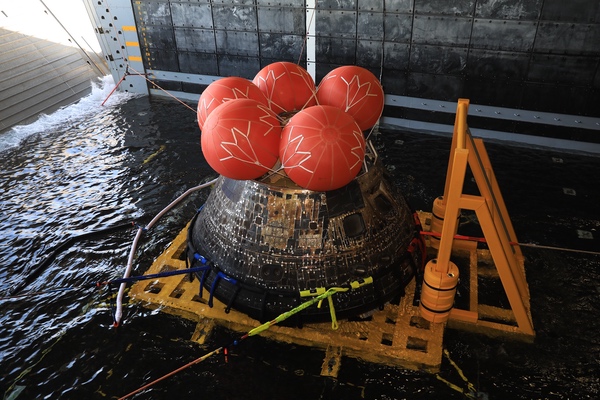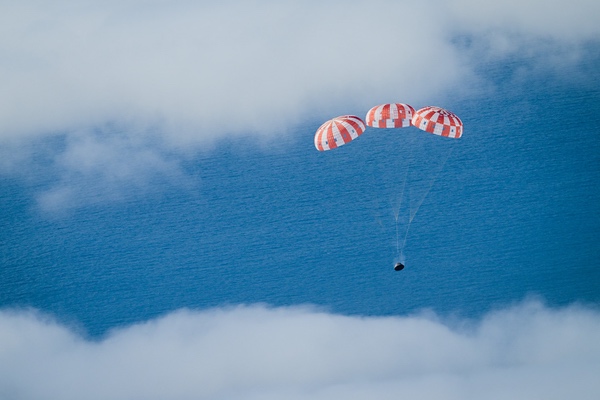All’s well that finally begins wellby Jeff Foust
|
| “We all came into the mission expecting to have challenges, and the team went through a lot of simulations and tests to be ready for the bad days, and instead it’s kind of purring along,” said Scoville. |
The uncrewed mission lifted off November 16 on the first flight of the Space Launch System (see “SLS showed up, at last”, The Space Review, November 21, 2022), with the rocket’s upper stage propelling Orion towards the Moon. After the launch, Orion performed four major maneuvers: a powered lunar flyby November 21 to send the spacecraft towards a distant retrograde orbit (DRO) around the Moon, a November 25 maneuver to enter DRO, a December 1 burn to leave DRO, and then another powered flyby of the Moon December 5 that put the spacecraft on a trajectory back to the Earth.
Artemis 1 was designed to be a shakedown cruise for the Orion spacecraft, putting it through its paces in cislunar space to show it was ready to carry astronauts. NASA officials, at many briefings held over the 25½-day mission, discussed “stressing” the spacecraft to see what worked, and what didn’t, before flying astronauts on Artemis 2 and subsequent missions.
By and large, the spacecraft passed those tests. “We all came into the mission expecting to have challenges, and the team went through a lot of simulations and tests to be ready for the bad days, and instead it’s kind of purring along,” said Zeb Scoville, deputy chief flight director, at one briefing. “The discussions we’re having is how to rev the engines a little a bit harder and how to push it.”
That extra revving of the engines came in the form of additional flight test objectives added during the course of the mission. There were 124 objectives originally planned, but as the mission progressed and engineers found few issues to deal with, they added over a dozen while in DRO and on the way back to Earth, such as testing the spacecraft’s thermal characteristics in different attitudes and performance of a valve in the propulsion system, all to further buy down risk for future crewed missions.
The mission was not problem free, but the issues they countered, project officials said, were mostly minor. The most persistent one was with devices called latching current limiters, a kind of circuit breaker in one part of the spacecraft’s power system. Those devices opened repeatedly over the course of the mission despite not being commanded to do so.
Engineers with ESA and Airbus, which built the service module, spent the final days of the mission performing what tests they could before the module was jettisoned just before reentry. “We don’t have an idea of what is the root cause. We are investigating, looking at all possible options,” said Philippe Deloo, ESA program manager for the service module, at a briefing two days before splashdown. He said possibilities included electromagnetic interference in the power system or from spacecraft antennas.
However, he and his Airbus counterpart, Ralf Zimmermann, emphasized the issue was a minor one, since the devices could be commanded to close whenever they opened, and affected only a small part of the overall power system. “It is a glitch, not a mission-critical failure,” said Zimmerman
The biggest test, though, would come at the end. NASA set out four top-level priorities for the Artemis 1 mission. The second of the four was to test out Orion systems in space, while the fourth was to perform miscellaneous tests and activities during the mission, and accounted for those 124+ objectives during the mission. The top priority, though, was to successfully test Orion’s heat shield by reentering at lunar return velocities, approaching 40,000 kilometers per hour. (The third priority, tied closely to the first, was to recover Orion after splashdown from that reentry.)
The reentry was the top priority given the critical nature of the heat shield and the fact it could not be tested on the ground. “There is no arcjet or aerothermal facility here on Earth of replicating hypersonic reentry with a heat shield of this size,” said Mike Sarafin, NASA Artemis 1 mission manager, a few days before splashdown. “It is a safety-critical piece of equipment. It is designed to protect the spacecraft and the passengers, the astronauts on board. So, the heat shield needs to work.”
The reentry, unlike the Apollo lunar returns, would use a “skip” technique where the capsule descends part way into the atmosphere, then ascends again to the edge of the atmosphere before reentering. That is designed to moderate the g loads on spacecraft occupants as well as provide more flexibility in selecting a landing location. (NASA, in fact, had to move the splashdown location by about 550 kilometers to the south because of a forecast of winds and rain at the primary location just west of San Diego.)
So, on December 11, NASA eagerly, and anxiously, followed Orion’s return. At 12pm EST, right on schedule, the crew capsule separated from the service module; the latter, having completed its mission, burned up in the atmosphere with any surviving pieces falling in the South Pacific west of Peru. Twenty minutes later, Orion reached the imaginary boundary dubbed the “entry interface” at the top of the atmosphere deemed the start of reentry.
| “This is what mission success looks like, folks,” Sarafin said. |
The skip reentry meant there would be not one but two blackout periods where the plasma surrounding the spacecraft would prevent communications. Each time Orion emerged on schedule and in good condition. It continued its descent, slowing as first drogues and then three main parachutes deployed. At 12:40pm, it splashed down within sight of the recovery ship, USS Portland, coming within 3.9 kilometers of the target (the mission requirement was an accuracy of 10 kilometers.)
At a briefing a few hours after splashdown, even as crews from the Portland were still working to bring the capsule into the ship after some post-splashdown tests, NASA officials were elated.
“This is what mission success looks like, folks,” Sarafin said. “We had a very successful flight test. We now have a foundational deep space transportation system.”
 Orion as it flew by the Moon on its way back to Earth December 15. (credit: NASA) |
Future plans
Sarafin and others at the post-splashdown briefing stressed that they were only starting to review the data from reentry, or even the mission in general. That included data from reentry collected during the blackout period and stored on the spacecraft. “Initial indications are very favorable, but there’s more ahead of us in terms of exactly understanding what the reentry flight test told us,” Sarafin said.
It was clear, though, that they were pleased with what they knew so far. “I would say we’re very happy with what we’ve seen so far on the heat shield,” said Howard Hu, NASA Orion program manager.
USS Portland, with Orion on board, will arrive in San Diego December 13. NASA expects to transport the capsule cross-country to the Kennedy Space Center by the end of the month for further studies.
Technicians will also remove several avionics units from the capsule, such as inertial measurement units and phased-array antennas. Those will be refurbished and reflown on the Orion flying Artemis 2. (Had they not been recovered, or if they can’t be reused for some reason, Hu said, they can turn to units that are being produced for the Orion flying Artemis 3.)
That puts a limit on how soon the next mission can fly, even if the rest of the Orion spacecraft and the next SLS are ready to go. Before Artemis 1, NASA estimated that Artemis 2 would be ready to fly about two years after Artemis 1.
Immediately after splashdown, NASA was sticking to that schedule. “Right now, we’re still looking at that two-year timeframe from Artemis 1 to 2,” said Jim Free, NASA associate administrator for exploration systems development.
“One thing we’ve always been concerned about is what do we learn from [Artemis] 1 and are there changes we have to make,” he continued. “We have learned a lot from 1. TBD if there’s any changes.”
“We obviously want to try and do it quicker,” he added, including lessons learned from processing Artemis 1.
| “Right now, we’re still looking at that two-year timeframe from Artemis 1 to 2,” said Free. “We obviously want to try and do it quicker.” |
NASA’s leadership, though, wasn’t concerned about losing the momentum built up by the success of the Artemis 1 mission over the next two years. “I’m not worried about the support from Congress,” administrator Bill Nelson said. “We will have that. We, in fact, have that.”
“I believe you will see continued talk about what’s going on when Vanessa announces who is on the crew,” he added, referring to Johnson Space Center director Vanessa Wyche. Earlier in the briefing, she said the agency had held off naming the crew on Artemis 2 until it saw what happened with Artemis 1, to avoid naming the crew too soon if there were problems. With Artemis 1 an apparent success, she said, that crew could be named in early 2023.
“That’s going to be an immediate story,” he said of the crew announcement, suggesting the public would be as interested in the four astronauts (one of which will be from Canada, as part of an agreement where Canada provides a robotic arm system for the lunar Gateway) as it was more than 60 years ago when NASA named the Mercury 7.
“Naturally, we would be concerned if that interest waned,” he added.
 Orion sitting inside the well deck of the USS Portland after splashdown. (credit: NASA) |
Forgetting past problems
The splashdown of Orion to conclude Artemis 1 was widely heralded by politicians, space agency leaders and others. People from different ends of the political spectrum, for example, came to the same conclusion about the mission.
“I applaud the NASA team for their work on completing a successful Artemis I mission. We’re one step closer to returning astronauts to the moon,” said Vice President Kamala Harris in a tweet after splashdown.
“Success! We are one giant leap closer to returning Americans to the Moon and a new era of deep space exploration,” said Rep. Brian Babin (R-TX), ranking member of the House space subcommittee, in another tweet.
Nelson, at the post-splashdown briefing, was not surprised. “NASA is basically nonpartisan,” he said, reiterating a point he often made during his three terms in the Senate. “R’s and D’s alike come together and join us.”
There was, in those salutes to the mission after splashdown, little, if any, mention of the problems that the program had suffered for years leading up to that point: nothing about the lengthy delays, high costs, or various technical problems suffered over the years. Success has a way of making people forget those past problems.
This is not the first time this has happened to NASA even this year. The James Webb Space Telescope has long been the subject of criticism for its major cost overruns and schedule delays. Yet, by the time it released its first images in July after a successful launch and commissioning over the previous six months, there was nothing but praise for JWST (see “The transformation of JWST”, The Space Review, July 18, 2022).
Success, it seems, can excuse, or at least make people forget, those past problems. All’s well that ends well—or perhaps, since both JWST and Artemis are only now getting started after years of development, all’s well that finally begins well.
| “I think that when we have private launch capabilities that rival this we should transition, and that will make me feel a lot better about the future and the future success of Artemis,” Garver said. |
However, the experiences of Artemis and JWST may not be the same going forward. For the space telescope, its costs are largely behind it: NASA still spends money to operate it and support science from it, but that will be a small fraction of the $10 billion that NASA and its partners spent to build and launch it. Moreover, it will be generating results continuously over potentially 20 years, with a steady stream of both striking images and compelling science already emerging from the mission.
NASA, though, still has to bear significant costs to build future SLS rockets and Orion spacecraft, along with other components of the overall Artemis campaign: ground equipment like a second mobile launcher (which has suffered its own serious cost and schedule problems), the lunar Gateway, and other elements. And, unlike the steady cadence of JWST images, the next Artemis launch is at least two years away.
NASA says its working to reduce the costs of Artemis over the long run, with a long-term contract in place with Lockheed Martin for later Orion spacecraft and a proposed similar contract with a Boeing-Northrop Grumman partnership for SLS. That’s intended to secure the future of those vehicles for Artemis missions well into the next decade.
“I think one of the biggest achievements is that there’s a lot of hardware here that has been under development for a long time,” former NASA administrator Jim Bridenstine said at a SpaceNews event last week. “The Artemis program just gave all that hardware a mission, which is what we needed in order to get to where we are today.”
Lori Garver, former NASA deputy administrator, also commended the agency at the event for the success of the mission, but was skeptical that current approach was the right one for Artemis in the long term, particularly as commercial options emerge.
“I do not believe that the country can or should probably spend the amount of money we are on launch infrastructure over the longer term,” she said. “I think that when we have private launch capabilities that rival this we should transition, and that will make me feel a lot better about the future and the future success of Artemis.”
Note: we are using a new commenting system, which may require you to create a new account.
